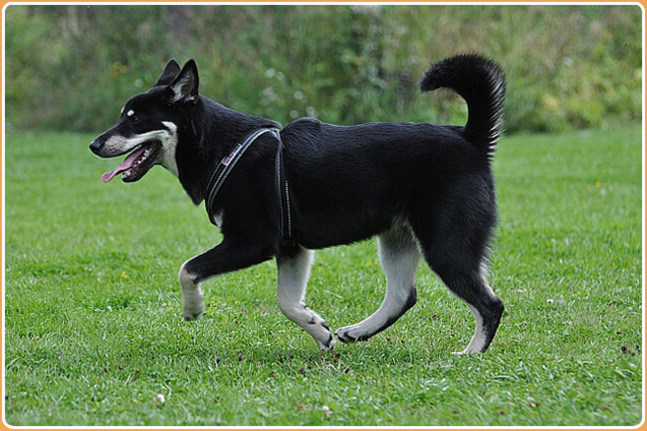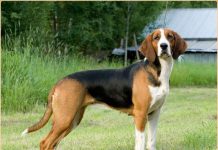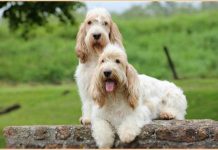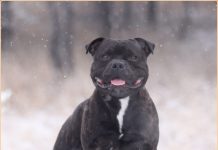The Lapponian Herder is one of Finland's five national breeds. As the name suggests, the dog was bred for herding. Contrary to other national breeds, this breed has shorter coat and it doesn’t carry its tail over its back. This breed was developed by Sami people for herding and guarding particularly Reindeer.
Like all herding dogs, it is also energetic and workaholic. It has an inquisitive nature and will always be in the search of fun. Generally, they are sweet tempered and amiable with human beings.
Never leave the Lapponian herder alone in the yard else it will end up tearing everything it come across. Early socialization will ensure a well-adjusted dog in your house. The dog is suitable for active owners who can satiate his desire to work and do exercise.
Inside home, they remain calm but needs average sized yard to live freely happy. The dog is relatively easy to housetrain because they are obedient in nature. They are also fond of children because children are the ones who can match their level of energy.

Lapponian Herder Origin
This breed is one of those three breeds that were developed by Sami people. Sami people are Finno-Ugric people that once lived in the Arctic region. The primary job of the dog was to herd Reindeer and other livestock and to protect them.
After World War I and II, this breed became on the verge of extinction. During the period of 1950s and 1960s, breeders tried to regenerate the old reindeer herding dog and as a result three breeds were developed Lapponian Herder, the Finnish Lapphund, and the Swedish Lapphund.
Lapponian Herder Characteristics
- The breed belongs to Finland and is herding breed.
- It is a friendly, courageous, alert and energetic breed.
- Lifespan of this breed is 12-14 years.
- Height of the breed is 48–54 cm.
- It weighs around 55-65 pounds.
- The dog comes in black, dark brown and grey colors.
- It is intelligent breed as well as keen listener. It is easy to train as it is eager to please master.
- The dog is suitable for apartment accompanied with average sized yard.
- It is not hypoallergenic breed.
- The dog sheds moderately. Brush its coat every day to keep lose hairs in control.
- Barking tendency of the dog is occasional.
- It is a suitable dog for family with kids and animals.
- The dog is active and needs ample amount of exercise to stay happy.
Appearance
The breed is of medium size and has a muscular built up body. Like other spitz breeds, it has wedged shaped forehead and pointed muzzle. It has pricked ear which sets atop its head. Eyes of the dog are almond shaped and pretty thoughtful.
Despite being from spitz family, its tail is not curved over its back rather it goes downward and then slight curved is made towards the end. The dog has muscular neck and leveled topline. Overall expression of the dog is intelligent, sweet and friendly.
-
Size and Weight
Ideal height of the male breed is 48–54 cm and ideal height of the female breed is 43–49 cm. Weight of the male breed is 45 to 55 pounds while female weight is 35 to 45 pounds.
-
Coat and Color
The dog has thick and dense coat that helps it to survive the cold climate of arctic region. It is double coated and has medium length hair. Undercoat is fine and soft that keep its body warm. Topcoat is rough and straight that protects it from thorns and bushes. The dog comes in three acceptable colors - black, dark brown and grey. Generally, undercoat is lighter than topcoat.
Temperament
- Personality - The dog has an outgoing personality. It especially adores kids. It can play whole day with them. They are also patient while approaching toddlers. They have the pack mentality which means it is tolerable of other animals including dogs. Few dogs are suspicious of strangers while few are friendly with them. It depends mostly on its socialization training. The dog is suitable for inside home but it is definitely not a dog that would lie all day without doing any work.
- Behavioral Traits - The dog has remarkable herding instincts. It also excels in other spheres of life as watchdog, rescue dogs, therapy dogs, search dogs The dog is more than happy when it has been given any responsibility of task. The dog is athletic in nature and outperforms in dog’s sports related to agility and obedience. This breed is not recommended for those who want a dog for companionship purpose only. Despite being a companion dog, it also needs daily dose of work to accomplish.
- Activities Requirement - Being a herding dog, the dog is full of energy. You need to fulfill its exercise needs to make it happy and healthy. They are happy dogs who love to explore the world. You can take the dog on trekking and hiking. You can also go on running, jogging or cycling with your dog.
- Trainability - The dog is easy to train provided you’re a good master. Be confident and gentle in training them. They have sharp mind and will never forget anything taught to them. The dog is obedient to its master and will do anything to please him. Never be harsh on your dog as that can make them rebel in nature.
Feeding
Their diet should include essential vitamins and minerals. They are greedy eaters, so feeding them requires careful attention. Fish, meat, bacon and beef should be given to them. As the dogs are canine in nature so barf diet (raw food) is best for them.
Lifespan
The dog can live up to 12 to 14 years.

Health Issues
This breed is not hypoallergenic. They are hearty and healthy breed with no major health issues. Genetic health issues include cataracts, progressive retinal atrophy and hip dysplasia.
Grooming
The dog is easy to groom. It sheds moderately and heavy shedding is done at the time of seasonal change. During the period of heavy shedding, its coat requires intensive care. At other time, you can alternatively brush its coat to avoid tangled hair, mats and debris.
Clean its ears on regular basis from vet approved solution. Trim its nails, if it doesn’t get wears off. Do not forget to brush its teeth daily to avoid bad smell from its mouth and dental related problems.
Habitat
They can do well in apartments as well as house accompanied with yards. Being a Nordic breed, they thrive in cold climates. During summers they should be kept inside home.
Lapponian Herder Pet Names
- Leila
- Sheila
- Moony
- Kabul
- Kidde
Things To Be Considered Before Buying
Pros
- They form great bonds with children and animals.
- They are excellent herding dogs. They can survive in extreme cold conditions and are dedicated towards work.
- They are people oriented dog. They love to please humans.
Cons
- They are not hypoallergenic.
- They are only suitable for cold climate areas.
- They make good watchdog however they are not good guard dogs. Because of their non-aggressive nature, they tend to be sweet with strangers.






